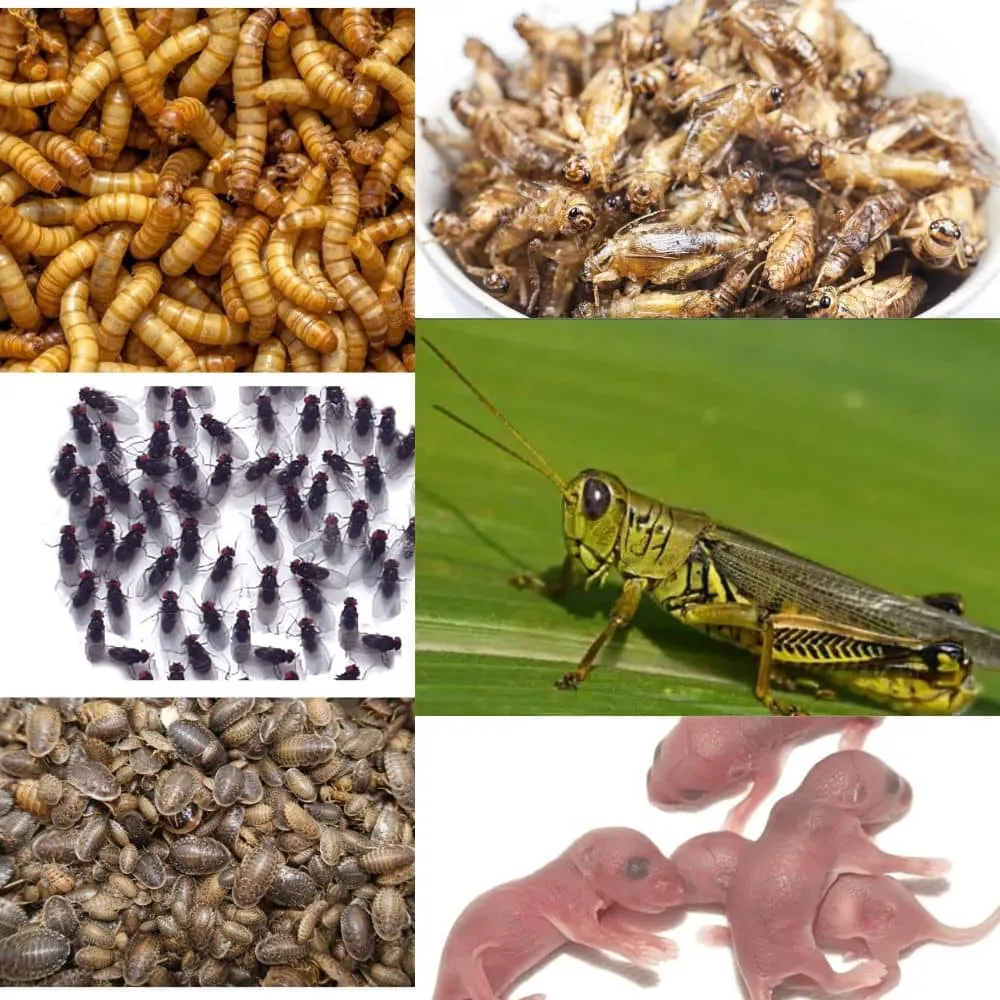What Do Baby Tarantulas Eat?
Caring for a baby tarantula is an exciting experience, and one of the most crucial aspects is providing the right diet. Spiderlings, as they are called, have different dietary needs compared to adult tarantulas. Understanding what baby tarantulas eat is fundamental for their healthy growth and development. Their diet typically consists of small insects, carefully chosen to match their size and nutritional needs. Proper feeding not only ensures the tarantula’s survival but also supports its molting process, which is essential for their growth. Baby tarantulas require a diet that is easy to catch, easy to digest, and rich in nutrients. The size of the prey is critical; it must be small enough for the tarantula to overpower and consume. Overfeeding is as dangerous as underfeeding, so careful observation and a well-planned feeding schedule are essential. With the right food choices, you can provide your baby tarantula with the best possible start to life.
Crickets The Staple Diet
Crickets are often considered the staple diet for baby tarantulas. These readily available insects provide a good source of protein and are usually easy for spiderlings to catch and consume. Crickets come in various sizes, making it easier to find appropriately sized prey for your growing tarantula. It’s essential to offer crickets that are smaller than the tarantula’s body size to prevent the tarantula from being overwhelmed or injured. When selecting crickets, it is important to ensure they are gut-loaded, meaning they have been fed nutritious food before being offered to your tarantula. This enhances the nutritional value of the crickets, providing your spiderling with essential vitamins and minerals. Furthermore, crickets should be sourced from reputable suppliers to minimize the risk of introducing parasites or pesticides into your tarantula’s enclosure. Monitoring the number of crickets and frequency of feeding helps maintain a healthy feeding routine, promoting optimal growth for your baby tarantula.
Size Matters Choosing the Right Crickets

The size of the crickets is arguably the most critical factor when feeding baby tarantulas. Offering prey that is too large can stress or even injure the tarantula. Ideally, the crickets should be no larger than the tarantula’s body length, excluding the legs. This ensures the spiderling can effectively hunt, subdue, and eat the prey without difficulty. You’ll need to assess your tarantula’s size regularly to adjust the cricket size accordingly as it grows. Young spiderlings may require pinhead crickets, while older spiderlings can handle slightly larger ones. Providing appropriately sized crickets minimizes the risk of the tarantula refusing to eat, which can lead to malnourishment. When introducing a cricket, it’s a good idea to observe the tarantula’s behavior to ensure it can successfully hunt and consume the prey. If the cricket is too large, the tarantula might ignore it or become frightened. Always remove any uneaten crickets after 24 hours to prevent them from bothering the tarantula.
Mealworms A Protein-Packed Treat
Mealworms serve as an excellent supplemental food source for baby tarantulas, providing a boost of protein and other vital nutrients. These larvae of the darkling beetle are relatively easy to obtain and store, making them a convenient option for feeding spiderlings. However, it’s important to note that mealworms have a tough exoskeleton, which can be difficult for very young spiderlings to digest. For this reason, they are often recommended for slightly older spiderlings that have matured a bit. Before offering mealworms, it is advisable to crush their heads to prevent them from burrowing and potentially harming the tarantula. Mealworms should be offered in moderation, not as a primary food source, to maintain a balanced diet. Gut-loading the mealworms with nutritious food before feeding them to your tarantula can also enhance their nutritional value, ensuring your spiderling receives a well-rounded diet. As with all food items, observe your tarantula’s eating habits and adjust the frequency and quantity of mealworms accordingly, keeping in mind their size and stage of development.
The Benefits of Mealworms
Despite their tougher exterior, mealworms offer several benefits as part of a baby tarantula’s diet. They are rich in protein, which is essential for the spiderling’s growth and development. The additional nutrients in mealworms aid in the molting process, ensuring the tarantula sheds its exoskeleton properly and grows larger. Mealworms are also relatively easy to manage and store compared to live crickets or other insect options. Their availability and the ease of keeping them make them a practical choice for many tarantula keepers. Offering a variety of food options also helps to prevent nutritional deficiencies and promotes the tarantula’s overall health. Mealworms, when used as a supplement, contribute to a varied and balanced diet, crucial for the spiderling’s vitality. However, moderation is key. Always monitor your tarantula’s reaction to mealworms and adjust the feeding schedule to promote healthy growth without overfeeding.
Fruit Flies A Tiny but Tasty Option

Fruit flies are an excellent food choice for very young baby tarantulas, or spiderlings, due to their small size and soft bodies. These tiny insects are easy for the spiderlings to capture and digest, making them an ideal first food. Fruit flies are a good source of protein and are often readily available at pet stores or can be cultured at home. The soft bodies of fruit flies are particularly beneficial, as they do not pose a risk to the spiderling in terms of injury. This is especially important for newly hatched spiderlings, which are vulnerable. When feeding fruit flies, it’s advisable to introduce them into the tarantula’s enclosure in small numbers, allowing the spiderling to hunt and consume them easily. This also helps in preventing uneaten fruit flies from causing any issues in the enclosure. Fruit flies provide essential nutrients and are easily manageable, making them a perfect choice for young tarantulas that are just starting to feed on their own.
The Importance of Fruit Flies for Young Tarantulas
Fruit flies play a crucial role in the diet of very young tarantulas, helping to kickstart their growth. Their small size is perfect for these tiny spiderlings, ensuring they can consume the food without difficulty. The nutrients in fruit flies help the spiderlings grow and develop, contributing to their overall health. By providing a readily available and easily digestible food source, fruit flies set the stage for the spiderling to grow at a healthy rate. The soft bodies of fruit flies ensure the spiderlings can eat without risking injury or stress. Fruit flies are relatively easy to culture or purchase, making them a convenient option for tarantula keepers. This consistency in the diet helps in ensuring that the spiderlings get the nutrients they require early on. With the right start, baby tarantulas have a great chance of growing into healthy adults. Fruit flies provide the solid foundation needed to give your baby tarantula a strong start in life, setting the tone for future feeding and growth.
Roaches Nutrient-Rich Delights
Roaches can be a valuable food source for baby tarantulas, providing a high-protein and nutrient-rich option. Roaches are relatively easy to breed and maintain, making them a convenient option for regular feeding. However, like mealworms, roaches can be a bit tough for very small spiderlings. Their exoskeletons are hard to break down, so they are better suited for tarantulas that are slightly older and more developed. When feeding roaches, it’s important to choose appropriate sizes to prevent the spiderling from becoming overwhelmed. Gut-loading the roaches before feeding them to your tarantula is essential. This increases their nutritional value, ensuring your spiderling receives a balanced diet. Roaches offer essential amino acids and other nutrients that contribute to the healthy development of the tarantula. While roaches can be a beneficial addition to the diet, it is essential to source them from a reputable breeder to prevent the introduction of parasites or diseases into the tarantula’s enclosure. Monitoring the tarantula’s feeding response and adjusting the roach size and frequency accordingly is crucial for a successful diet.
Types of Roaches to Consider

Several species of roaches are suitable for feeding to baby tarantulas, but some are better than others. Dubia roaches are commonly used and are a great choice, as they are relatively soft-bodied and easy to breed. Another option is the lobster roach, which is also nutrient-rich, though they can be a bit faster and might be a challenge for smaller spiderlings to catch. When selecting roaches, it’s important to consider their size, ease of care, and nutritional value. Avoid using wild-caught roaches, as they can carry parasites or pesticides that can harm your tarantula. The main goal is to provide a safe, nutritious, and easily digestible food source. The choice of roach species will depend on the size of your tarantula and your ability to manage the feeder insects. Always research different roach species and select the ones that best fit your tarantula’s needs, ensuring a healthy and balanced diet. By making smart decisions about roach species, you can help ensure your baby tarantula thrives.
Spiderlings and Their Dietary Needs
Understanding the dietary needs of spiderlings is essential for successfully raising baby tarantulas. Spiderlings are in their most vulnerable stage of life, so providing the right food is critical for their survival and development. Baby tarantulas need a diet rich in protein to support rapid growth and molting. The right food ensures the spiderling grows at a healthy rate and molts properly. It’s vital to monitor the spiderling’s eating habits closely and adjust the feeding schedule according to its size and appetite. Overfeeding can be as detrimental as underfeeding, so observing the tarantula’s behavior and adjusting the food quantity is essential. Variety is key, so providing different food options helps prevent nutritional deficiencies and keeps the spiderling interested in eating. By adhering to these dietary guidelines, you can provide your baby tarantula with the best start in life and help them thrive into healthy adults. Proper feeding is not just about providing food; it’s about providing the right food at the right time.
